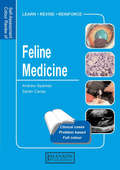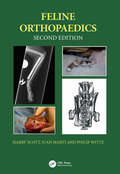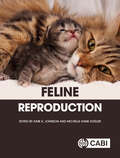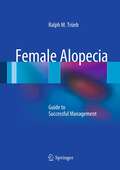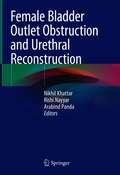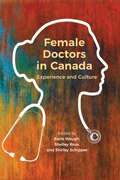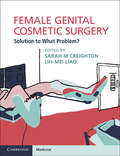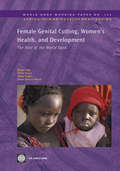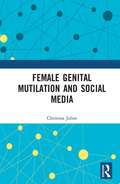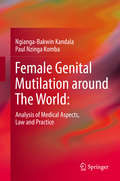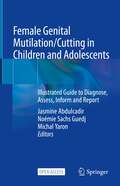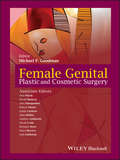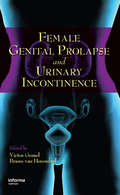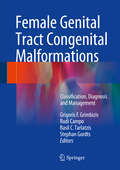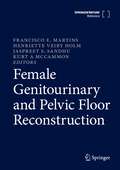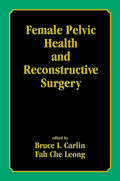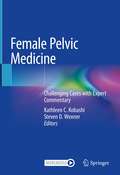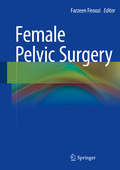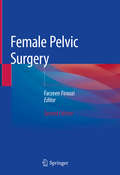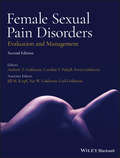- Table View
- List View
Feline Medicine: Self-Assessment Color Review (Veterinary Self-Assessment Color Review Series)
by Andrew Sparkes Sarah M.A. CaneyIn this new volume, part of the Veterinary Self-Assessment Colour Review series, the authors aim to cover all aspects of feline medicine. Questions cover areas such as dermatology, ophthalmology, urinary tract, oral cavity/oesophagus, GI tract, endocrinology, cardiology, respiratory disease, infectious disease, reproductive disease, neuro-muscular
Feline Orthopaedics
by Harry Scott Juan M. Marti Philip WitteCats are not referred to specialists as frequently as dogs, meaning the general practitioner must routinely treat cats that have been involved in road traffic accidents and other musculoskeletal trauma. This book is the first of its kind to provide a practical and user-friendly guide to feline orthopaedics. With a new author team, led by RCVS Specialist in Small Animal Surgery (Orthopaedics) and Veterinary Neurology Harry Scott, the second edition has been thoroughly revised and updated. New chapters cover Physiotherapy and Oncology of the Feline Skeletal System. The book includes highly structured fully referenced text that provides a concise, straightforward guide to the recognition and management of specific diseases and conditions. In this new edition, the neurological causes of lameness have been given more in-depth discussion, with an emphasis on early recognition of clinical signs and diagnosis. The disorder sections are now divided into those likely to be associated with trauma (fractures and luxation) and those which are congenital or developmental. The text is supported by high quality radiographs, colour photographs and colour line drawings to illustrate principles, techniques and procedures. Combining their experience in practice and education, the authors have produced a book that appeals to general practice veterinarians, specialist feline practitioners and to students.
Feline Reproduction
by Natalie S Fraser Carla Barstow Marco Cunto Diane Delmain Jaime M. Douglas Alain Fontbonne Cristina Gobello Sandra Goericke-Pesch Fiona Hollinshead Jacob A. Johnson Cindy Maenhoudt Jennifer Nagashima Zuzanna Niewiadomska Budhan Pukazhenthi Juliette Roos William F. Swanson Riley E. Thompson Lindsey M. Vansandt Daniele ZambelliCats are one of the most popular pets in the world and cat owners want advanced veterinary care. There is a growing interest in purebred cats which requires the highest quality reproductive care from the general veterinary practitioners. In Feline Reproduction, all aspects of reproduction in the queen and the tom are presented by a global author team. Beginning with basic anatomy and normal reproduction, this book reviews practical knowledge about feline pregnancy, neonatal care, breeding soundness exams, and semen cryopreservation. This book also provides the most current and comprehensive information about abnormal conditions affecting feline reproduction, such as infertility, spontaneous abortion and contraception. Covering both pets and nondomestic species, this feline reproduction book will prove to be essential for the general veterinary practitioner, veterinary student, animal scientist, and experienced cat breeder.
Female Alopecia
by Ralph M. TrüebFew dermatologic problems carry as many emotional overtones as hair loss in women, which is by far the most common hair problem encountered in daily clinical practice. Fortunately, a specific diagnosis can usually be established through the application of appropriate examinations and tests, and treatment suited to the diagnosis is likely to control the problem. This comprehensively illustrated monograph provides both specialists and primary care physicians with the practical know-how required for successful management of hair loss in female patients of all ages. The book opens by critically examining various myths about hair loss. The different examination techniques are then described, and the various forms of hair loss and their treatment are discussed in detail. Approaches to follow-up are outlined, and the management of patient expectations is carefully considered. The potential role of hair care and cosmetics is also explored in some depth.
Female Bladder Outlet Obstruction and Urethral Reconstruction
by Nikhil Khattar Rishi Nayyar Arabind PandaUrinary symptoms in women have a very high prevalence rate. While the storage function of the bladder is similar in both genders, voiding function has marked differences with obvious anatomic and physiological genitourinary distinctions. Despite all advances in contemporary diagnostics and imaging, female bladder outlet obstruction and urethral stricture disease remain a conundrum to be deciphered in clinical practice. It is also seen that the female voiding symptoms and bladder outlet obstruction are poorly understood entities; which is also evident from the fact that Urethral dilatation in women is still a widely practiced procedure. This book provides a comprehensive understanding of female voiding disorders leading to bladder outlet obstruction and helps identify the women who will actually need reconstructive surgeries. The book begins with what is normal female voiding and then goes on to describe the various definitions of female bladder outlet obstruction along with controversies in Urodynamic diagnosis . As the functional causes are more common than actual strictures, this book elucidates on the knowledge of each of these differentials with their basic understanding and treatment outline, further throwing knowledge on the anatomical causes like pelvic organ prolapse and female urethral stricture. A separate section is dedicated to female urethral surgical anatomy and urethral reconstruction for urethral stricture as well as pelvic fracture urethral injury in females.
Female Cancers: A Complementary Approach
by Jan de VriesTo many people, being diagnosed with cancer is tantamount to a death sentence and among women, rates of breast and ovarian cancers are still very much on the increase. Conventional treatments such as radiotherapy and chemotherapy can have horrific side effects, and doctors and specialists are only too happy when patients adopt additional complementary methods of combating the disease. Female Cancers, the latest title in the popular Well Woman series by Jan de Vries, succinctly addresses the main issues involving the treatment of cancers affecting women today. It advises on the ways that women can decrease the likelihood of contracting the disease and explains what sufferers can do to improve their chances of recovery.The book focuses on the confusion regarding the link between HRT and cancer, and further investigates the foods widely reported to cause the disease. It reveals how alternative medicine can help, for instance, by building up the patient's immune system to stand up to the attacks of agressive therapies. Jan de Vries has worked in this field for over 45 years and is a member of several research committees, including the Cancer Control Society. In Female Cancers, he shares his up-to-date knowledge of the new developments of cancer therapy and signposts the complementary help that can be given to assist female cancer patients.
Female Doctors in Canada: Experience and Culture
by Shelley Ross Earle Waugh Shirley SchipperFemale Doctors in Canada is an accessible collection of articles by experienced physicians and researchers exploring how systems, practices, and individuals must change as medicine becomes an increasingly female-dominated profession. As the ratio of practicing physicians’ shifts from predominately male to predominately female, issues such as work hours, caregiving, and doctor-patient relationships will all be affected. Canada's medical education is based on a system that has always been designed by and for men; this is also true of our healthcare systems, influencing how women practice, what type of medicine they choose to practice, and how they wish to balance their personal lives with their work. With the intent to open a larger conversation, Female Doctors in Canada reconsiders medical education, health systems, and expectations, in light of the changing face of medicine. Highlighting the particular experience of women working in the medical profession, editors trace the history of female practitioners, while also providing a perspective on the contemporary struggles women face as they navigate a system that was tailored to the male experience, and is yet to be modified.
Female Genital Cosmetic Surgery: Deviance, Desire and the Pursuit of Perfection
by Camille NurkaExamining the fascinating history of female genital cosmetic surgery, Camille Nurka traces the origins of contemporary ideas of genital normality. Over the past twenty years, Western women have become increasingly worried about the aesthetic appearance of their labia minora and are turning to cosmetic surgery to achieve the ideal vulva: a clean slit with no visible protrusion of the inner lips. Long labia minora are described by medical experts as ‘hypertrophied,’ a term that implies deformity and the atypical. But how far back does the diagnosis of labial hypertrophy go, and where did it originate? Female Genital Cosmetic Surgery tells the story of the female genitalia from the alien world of ancient Greek gynaecology to the colonial period of exploration and exploitation up to the present day. Bringing together historical, medical, and theoretical documentation and commentary, Nurka uncovers a long tradition of pathologizing female anatomy, a history sure to be of interest to any reader who wishes to know more about how medicine shapes our commonly held ideals.
Female Genital Cosmetic Surgery: Solution to What Problem?
by Sarah M. Creighton Lih-Mei LiaoAn analysis of the cultural and economic drivers of the growing phenomenon of FGCS, written by cross-disciplinary experts, this book challenges the concept of individual consumer choice in FGCS: a decision that is rarely exercised in a socio-cultural vacuum. Four distinct aspects of FGCS are covered: variations in female genital anatomy; surgical techniques and evidence; historical contexts and ethical dilemmas; norm-critical understandings to inform professional responses. Rendering philosophical critiques accessible, and exposing dubious social values that underpin the practice, this text is crucial in driving a broader understanding of FGCS as a cultural phenomenon of our times. Only with a fuller understanding of the multiple perspectives of FGCS, can there be sensible alternatives for women and girls psychologically troubled by their natural, healthy form. Offering explanations and interventions at individual, institutional and societal levels, this text will be valued by both professional and non-professional audiences.
Female Genital Cutting, Women's Health, and Development
by Khama Rogo Tshiya Subayi Eiman Hussein Sharief Nahid Toubia'Female Genital Cutting, Women's Health, and Development' provides a comprehensive understanding of the issue of female genital mutilation/cutting-scope, challenges, opportunities, best practices, and how communities, development agencies, and national governments can work together to eliminate the practices on the ground. The World Bank is committed to assisting governments in ending the practice of female genital cutting, as the practice has direct, negative impact on the health and well-being of women around the world. The recommendations set forth in this paper take advantage of the World Bank's comparative advantage in dealing with governments. Continued silence perpetuates the practice, thereby undermining women's productivity.
Female Genital Mutilation
by Comfort MomohThis unique book will assist those who care for women and girls who have had, or are at risk of having female genital mutilation. It focuses on caring for both physical and mental needs of the vulnerable or suffering and maintains an understanding, holistic and objective approach to the current situation. It contains colour plates, illustrations, p
Female Genital Mutilation and Social Media
by Christina JuliosThis book explores the phenomenon of anti-femail genital mutilation (FGM) social media activism. Against a backdrop of over 200 million girls and women worldwide affected by FGM, this volume examines key global online campaigns to end the practice, involving leading virtual platforms such as Twitter, Facebook and YouTube. Drawing from twenty-one fieldwork interviews with anti-FGM activists, frontline practitioners and survivors, the volume investigates opportunities and challenges inherent to cyberspace. These include online FGM bans as well as practices such as ‘cyber-misogyny’ and ‘clicktivism’. Global campaigns featured include the UN’s International Day of Zero Tolerance for FGM, the WHO’s Sexual and Reproductive Health Programme, The Girl Generation, The Guardian’s End FGM Global Media Campaign and the Massai Cricket Warriors. Furthermore, ten case-studies document prominent anti-FGM campaigners. Firstly, five African-led narratives from celebrated activists: Efua Dorkenoo OBE, Waris Dirie, Ayaan Hirsi Ali, Jaha Mapenzi Dukureh and Leyla Hussein. Second, five accounts from FGM survivors interviewed for the book: Mama Sylla, Masooma Ranalvi, Farzana Doctor, Fatou Baldeh and Mariya Taher. By exploring anti-FGM online activism, this book fills a gap in the literature which has largely overlooked FGM’s presence in cyberspace as a virtual social movement. Female Genital Mutilation and Social Media will be of interest to activists, survivors, frontline professionals, students, academics and the wider public.
Female Genital Mutilation around The World: Analysis of Medical Aspects, Law and Practice
by Ngianga-Bakwin Kandala Paul Nzinga KombaThis book uses global household data to examine the prevalence, trends and geographic variation of female genital mutilation (FGM) around the world. It also addresses the underlying legal and policy aspects as well as explores the medical consequences, both immediate and long term, for those undergoing the practice. The book analyses the position of victims of this gender-based violence both from the medical and legal perspective and adopts a largely practical approach to the study of the practices, offering a fresh thinking into one of the challenges in global health and the law. In addition, it offers some insights into how health professionals can approach this category of victims and how legal practitioners can obtain a good legal result for their clients before domestic and international forums. The book addresses fundamental issues such as state liability and defences in enforcement proceedings for actions or omission of state or non-state actors, and due diligence standard in international human rights law, the main gateways available for obtaining relief for the victims of FGM. This book goes beyond the traditional debate between zero tolerance and those who wish to see the practice medicalised and tolerated and favours an advocacy programme standing firmly in favour of the right of FGM victims. This book offers a unique perspective likely to assist victims and their representatives to secure a remedy against perpetrators and the state. As such this book will be of interest to medical professionals, national and international lawyers, academics and policymakers in the field of public health.
Female Genital Mutilation/Cutting in Children and Adolescents: Illustrated Guide to Diagnose, Assess, Inform and Report
by Jasmine Abdulcadir Noémie Sachs Guedj Michal YaronThis open access illustrated guide focuses on Female Genital Mutilation/Cutting (FGM/C) in children and adolescents. FGM/C comprises all procedures that involve partial or total removal of the external female genitalia or injury to the female genital organs for nonmedical reasons. It is mainly carried out during childhood, before the age of 15. The signs of FGM/C can be subtle, and the examiner must be trained with a wide range of normal genitalia both before and after puberty, FGM/C types and subtypes, complications and differential diagnosis. This volume is a reference containing iconographic material of both pre and post pubertal genitals with and without genital cutting. This book will guide health care professionals in making the correct diagnosis, outline the clinical management, enhance patient–provider communication, and will enable accurate recording and reporting to governments where required.
Female Genital Plastic and Cosmetic Surgery
by Robert Moore Andrew Goldstein David Veale Michael P. Goodman Bernard Stern Marci Bowers Alex Simopoulos David Matlock John Miklos Linda Cardozo Otto Placik Gail GoldsteinFemale genital plastic surgery has become an increasingly sought-after option for women seeking ?improvement? in genital appearance, relief from discomfort, and increased sexual pleasure. These surgeries are a combination of gynecologic, plastic, and cosmetic procedures. Every year sees a higher demand for physicians properly trained and able to perform them. This unique text from the acknowledged experts in the field covers; the anatomy of the area the specific surgical procedures and all their variations patients? rationales for surgery training guidelines and ethical issues outcome statistics sexual issues patient selection potential risks and complications. Examining the issues from individual patient?s perspectives, it is written in an academic but easy-to-read style with understandable and unambiguous drawings and photographs. It contains a step-by-step surgical approach, how to best select the right surgical candidates, how to treat this select group of patients, the sexual issues involved, how to individualize techniques for each specific patient, how to deal with criticism from colleagues or journalists, psychosexual issues, and patient protection.
Female Genital Prolapse and Urinary Incontinence
by Victor G. Gomel Bruno Van HerendaelGenital prolapse, or pelvic organ prolapse, occurs when the structures of the pelvis protrude into the outside vaginal canal. Genital Prolapse and Urinary Incontinence is the first book of its kind dedicated specifically to genital prolapse and is filled with every different type of prolapse, including the bladder, uterus, rectum, and
Female Genital Tract Congenital Malformations
by Basil C. Tarlatzis Grigoris F. Grimbizis Rudi Campo Stephan GordtsFemale genital malformations represent miscellaneous deviations from normal anatomy. With a prevalence of approximately 6% in the general population, they might be associated with health problems, potentially dangerous complications or poor reproductive outcome depending on the type and the degree of the anatomical abnormality. During the last two decades the better understanding of their pathogenesis, the availability of new non-invasive techniques for their diagnosis and the increased experience from their treatment have radically changed their management. A new, clinically oriented classification system has now been developed facilitating their evidence-based appraisal. It is a reality that the management of female genital malformations has changed rapidly during the last few years from an experience based and mainly descriptive field to a scientific evidence-based one. This book presents all uterine, cervical and vaginal anomalies in a systematic way and the new ESHRE/ESGE classification system utilised for their categorization. In addition, their embryogenesis and etiology are summarized. The diagnostic work-up of women with female genital malformations is reviewed in an evidence-based fashion and taking into account the availability of new non-invasive diagnostic methods. The treatment strategy and the therapeutic alternatives to restore health and reproductive problems associated with their presence are critically reviewed.
Female Genitourinary and Pelvic Floor Reconstruction
by Jaspreet S. Sandhu Francisco E. Martins Henriette Veiby Holm Kurt A McCammonThis book provides a comprehensive guide to the latest techniques in female genitourinary and pelvic floor disorders. It features detailed insight into these conditions along with detailed descriptions of how treatment has changed in recent times for these disorders. The latest methodologies for pharmacological treatment, conservative therapy, surgical techniques, and how to avoid potential complications are discussed. Topics including relevant neurophysiology, measurement of urinary symptoms, pelvic organ prolapse and ureteral reconstruction are covered. Female Genitourinary and Pelvic Floor Reconstruction is a detailed resource detailing the latest developments in the field, making it an ideal resource for all clinicians who encounter these patients in their daily practice.
Female Pelvic Health and Reconstructive Surgery
by Bruce I. Carlin Fah Che LeongDetails specific surgical techniques as well as the efficacy and efficiency of each modality to restore normal organ function, prevent secondary health consequences, and improve patient quality of life. Emphasizes the importance of thorough office evaluations to classify symptoms and plan appropriate therapeutic interventions for urinary incontinen
Female Pelvic Medicine: Challenging Cases with Expert Commentary
by Kathleen C. Kobashi Steven D. WexnerThis book is designed as a guide for management of advanced clinical scenarios encountered by the contemporary pelvic floor surgeon. It is organized by pelvic floor disorder (PFD) and covers the evaluation and treatment of urinary incontinence, fecal incontinence, and pelvic organ prolapse. Opening chapters in each section cover the fundamentals of proper and comprehensive assessment of patient PFDs, as well as the treatment options that are available for each disorder. The book then focuses on more complex and challenging situations that are becoming more frequently encountered as the number of patients being treated for PFD increases and the length of patient follow-up grows. Each chapter finally includes an expert commentary to address these new scenarios and offers a shifted approach from that required for treatment-naïve patients.Female Pelvic Medicine: Challenging Cases with Expert Commentary teaches the reader how to approach the most difficult of clinical situations in a multidisciplinary fashion.
Female Pelvic Surgery
by Farzeen FirooziFemale Pelvic Surgery: A Comprehensive Guide provides a comprehensive, state-of-the-art surgical review of this field and will serve as a valuable resource for clinicians and surgeons. The text reviews the basic indications for treatment and details the many surgical approaches to the management of all pelvic floor disorders. In addition to step-by-step description in text, the volume provides illustrations/photographs of surgical techniques. Integration of surgical videos demonstrating the major repairs described in each section augment the textbook and serve as the ultimate format for the education of clinicians and surgeons. Female Pelvic Surgery: A Comprehensive Guide provides a concise and comprehensive review of all the surgical approaches to female pelvic surgery and thus it will serve as an extremely useful resource for physicians dealing with and interested in the treatment of pelvic floor disorders.
Female Pelvic Surgery
by Farzeen FirooziThe fully updated edition of this text provides a state-of-the-art surgical review of female pelvic surgery, and will serve as a valuable resource for clinicians and surgeons dealing with, and interested in the treatment of pelvic floor disorders. The book reviews the basic indications for treatment and details the many surgical approaches to the management of all pelvic floor disorders, including stress urinary incontinence, transvaginal prolapse, transabdominal sacrocolpopexy, robotic/laparoscopic sacrocolpopexy, vaginal and vulvar cysts, and interstitial cystitis/bladder pain syndrome. In addition to step-by-step descriptions, the text is augmented with illustrations and photographs of surgical techniques demonstrating the major repairs described in each section.Written by experts in their fields, the second edition of Female Pelvic Surgery provides a concise and comprehensive review of all surgical approaches to female pelvic surgery.
Female Sexual Pain Disorders
by Andrew Goldstein Caroline Pukall Irwin GoldsteinFirst book devoted to the diagnosis and treatment of sexual pain in womenFemale Sexual Pain Disorders is a remarkable fusion of clinical and scientific knowledge that will empower women's healthcare professionals to help their patients in overcoming this common debilitating disorder. Based on the highest level research, it provides state-of-the-art practical guidance that will help you to:Evaluate and distinguish the causes of sexual pain in women Differentiate the many forms of sexual pain Implement multidisciplinary treatmentsDistilling the experience of world leaders across many clinical, therapeutic and scientific disciplines, with an array of algorithms and diagnostic tools, Female Sexual Pain Disorders is your ideal companion for treating the many millions of women who suffer from this disorder worldwide.All proceeds from this book are being donated to the International Society for the Study of Women's Sexual Health (ISSWSH).
Female Sexual Pain Disorders: Evaluation and Management
by Irwin Goldstein Gail Goldstein Andrew T. Goldstein Sue W. Goldstein Caroline F. Pukall Jill M. KrapfA comprehensive reference for the diagnosis and treatment of female sexual pain disorders Female Sexual Pain Disorders: Evaluation and Management, 2nd Edition compiles the most cutting-edge and modern research on sexual pain disorders in women into a single reference. It is the first book of its kind devoted to the diagnosis and treatment of sexual pain in women and is now fully updated in a second edition. The book includes diagnostic tools to differentiate among different forms of dyspareunia, discussions of potential causes of sexual pain, and current knowledge in multi-disciplinary treatments for dyspareunia. Focused on providing practical guidance to the working practitioner, this book includes information to: Help evaluate and distinguish the causes of sexual pain in women Assist in the differentiation of the many forms of sexual pain Implement multi-disciplinary treatments Female Sexual Pain Disorders is perfect for any healthcare worker who is involved in treating women’s sexual health, including gynecologists, urologists, internists, family practitioners, nurse practitioners, physician assistants, midwives, psychologists, and sex therapists.
Female Survivors of Sexual Abuse
by Christine D. BakerHow can we treat survivors of sexual abuse more effectively?Sexual abuse against females is a serious problem in society and there is a need for a greater understanding of the presentation and treatment of adult survivors of sexual abuse. In Female Survivors of Sexual Abuse, Christine Baker combines her clinical experience with an innovative approach to the treatment of this problem.Female Survivors of Sexual Abuse addresses the experience of 180 female adults who were sexually abused in childhood, and provides detailed analyses and treatment approaches. The subject matter is presented in an accessible and compassionate way, imparting personal opinion and experience. It covers:* female survivors: their stories, and the evidence* integration, the alliance and the therapist* the survivor's journey to recovery* the families, disclosure and the role of the mother.This book enables the reader to "enter" the experience of the survivors and follow their progress to recovery, while highlighting the ever-changing state of knowledge in this difficult area. It will be invaluable to practitioners and students of clinical psychology, counselling, and psychiatry.
